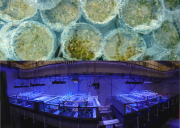NESP TWQ Round 2 - Project 2.1.6 - From exposure to risk: novel experimental approaches to analyse cumulative impacts and determine thresholds in the GBRWHA
Understanding cumulative impacts from multiple stressors is critical for successful management of the GBR under the Reef2050 Plan. The project produced experimental analyses of concentration-response relationships for selected species under broad, controlled envelopes of sediments, turbidity, nutrients, light, salinity and temperature. Based on new understanding of threshold exposure values, existing and new field data the project has enabled exposure maps for individual stressors to be produced and exploratory techniques to summarise those into cumulative exposure maps. Results have informed spatial and temporal assessments of ecological risks, and management opportunities for a range of activities in the coastal zones and inshore GBR waters.
Project Reports / Papers
Project reports, papers and presentations are available on the 2.1.6 project page on the NESP TWQ hub website.
Project Extension
This project was extended NESP TWQ Round 5 - Project 5.2 – From exposure to risk: Novel experimental approaches to analyse cumulative impacts and determine thresholds in the Great Barrier Reef World Heritage Area (GBRWHA)
Images
Datasets

This data contains consists of one Excel spreadsheet file containing the thermal stress data used to develop the Species Sensitivity Distribution described in the publication: Negri, A.P., Smith, R.A., King, O., Frangos, J., Warne, M. St-J., Uthicke, S. (2019) Adjusting tropical marine water quality guideline values for elevated ocean temperatures Environmental Science and Technology 54: 1102-1110 DOI: 10.1021/acs.est.9b05961.

The aim of this study was to investigate the effects of the herbicide diuron and climate change on the Photosystem II activity of the seagrass Halophila ovalis. The 3 climate conditions were: ambient (28.5 °C, 398 µatm), 2050 (29.5 °C, 682 µatm) and 2100 (30.5 °C, 873 µatm). This dataset consists of one data file (spreadsheet) from a 2-week experiment, containing 5 diuron concentrations and 3 climate change scenarios. Each tab contains photosynthetic yield data at each time point: 0 d, 2 d, 7 d and 14 d under each of the diuron and climate change treatments.

This dataset contains data from experiments testing the survival of fertilised Acropora millepora gametes before and after settlement in different climate and sediment treatment conditions. One datafile shows the development and survival until competency for settlement, which has been tested at the National Sea Simulator. A second file demonstrates the settlement success after development in these treatments.

This dataset consists of two data files (spreadsheets) from a 15 days experiment simulating the combined effects of climate change (manipulated temperature and pCO2 from present days and predicted for 2050 and 2100) and diuron contamination. Photosynthetic parameters were used to evaluate the physiological responses of Halimeda opuntia.

This dataset shows the measured response of early life history stages to different levels of nutrient enrichment and temperatures in experiments conducted in 2014-2015.
The data is presented as one Excel spreadsheet file. Each tab contains data from experiments (Exp. 1a,b; Exp 1c,d; Exp. 2; Exp 3) on different life stages exposed to the same conditions. Measured logged water quality (Nutrients) and temperature (Temperature) data taken during the experiment are also presented in different tabs.





